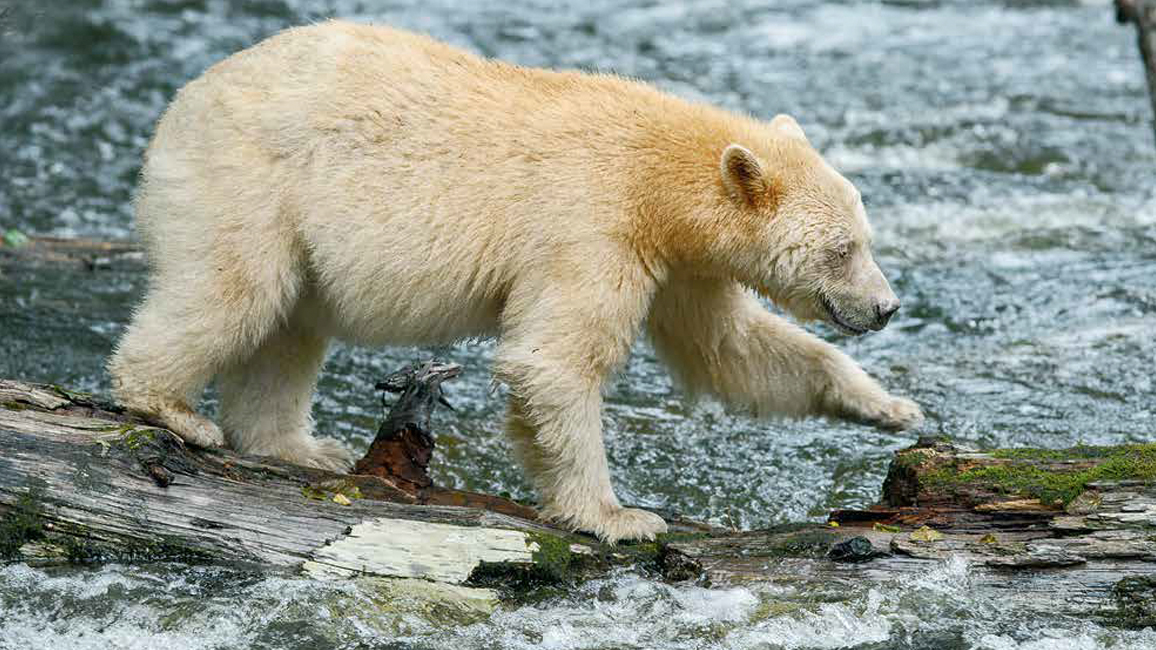
Spirit Bears
By Hannah SchardtWhat is this pale-furred creature lounging in the woods below? A polar bear that’s lost its way? Nope—it’s an even rarer bear: a Kermode (kur-MOH-dee) bear.
Kermode bears live only in the Great Bear Rainforest—a partly protected area in the islands and coastal forests of Canada’s British Columbia. Most Kermode bears have dark fur, but some are white, which earned them a ghostly nickname: spirit bears.
No one knows for sure how many spirit bears there are, but scientists believe there are only a few hundred white ones. Not many people have been lucky enough to spot one. For a glimpse into the secret world of spirit bears, keep reading below.
A WHITE BLACK BEAR
Spirit bears can be almost as white as polar bears, but don’t let that pale fur fool you. A spirit bear is actually a kind of black bear. Only about one in ten has white or cream-colored fur, though the ratio is different on each island.
So if they are BLACK bears, why are some spirit bears white? Scientists believe that, thousands of years ago, a black bear was born with a mutation (myoo-TAY-shun), or a change in its genes, that made it white. When that bear had cubs—and grandcubs, and greatgrandcubs—some of them were also born white. Even those with dark fur sometimes went on to have white cubs.
White spirit bears are not albino—born with little pigment, or color, in their skin, eyes, and fur. As you can see in these photos, they still have dark noses and eyes. They aren’t closely related to polar bears, either. They are just black bears that are white.
FAMILY TIME
Spirit bears spend most of their time alone—except when moms are raising babies. After mating, a mom finds a cozy den in the hollow of an old tree and huddles down for the winter. In December or January, she gives birth to one to four cubs.
The cubs spend the rest of the cold winter months snuggled close to Mom, drinking her milk. Even once they’ve left the den tree and moved on to solid meals, they stick around for another year or so while Mom protects them from harm.
SACRED BEAR
Native Americans have shared Canada’s rainforest islands with spirit bears for thousands of years. They always believed these bears were special. Some even thought the bears had supernatural powers.
According to native legends, spirit bears could swim deep underwater and lead people to magical places. Legend also has it that Raven, the Creator, made every tenth black bear on one island white as a reminder of the last ice age, which was 10,000 years ago.
Some native people who lived near the bears honored them by carving masks such as the one above.
TIME TO EAT!
A spirit bear is a special bear, indeed. But it is still a wild bear. And like any wild bear, it needs to eat—a lot.
Like most bears, spirit bears eat plant material, such as berries and grass. But they also get to eat barnacles and mussels along the shore. And for part of the year, they feast on salmon, which swim up coastal streams each year to spawn, or lay eggs. One spirit bear may catch dozens of salmon in a day!
When it comes to salmon-eating bears, a white coat is the right coat. Scientists found that spirit bears have better luck catching fish than their darker-furred relatives—at least during the daytime. A white bear isn’t as visible as a dark one to fish looking up toward a bright sky. So fish aren’t as likely to spot a white spirit bear and swim off in a hurry.
FOREST FARMERS
British Columbia’s salmon-rich coastal forests make a perfect home for spirit bears. But the bears also help the forests. Here’s how:
When a bear catches a salmon, it doesn’t chow down right in the river. It may carry its meal half a mile into the woods. And it usually doesn’t eat the whole fish. In fact, sometimes it eats only the eggs that may still be inside a female fish. When the bear is full or moves on to another meal, it leaves the salmon leftovers behind. These break down and make great fertilizer, or nutrients, for the trees. Scientists have found that trees that live where there are salmon-eating bears grow bigger and healthier than other trees.
Helping the forest where you live? Now that’s the spirit, bears!
“Spirit Bears” originally appeared in the September 2014 issue of Ranger Rick magazine.
(Click on each image above for a closer view of the story.)



















